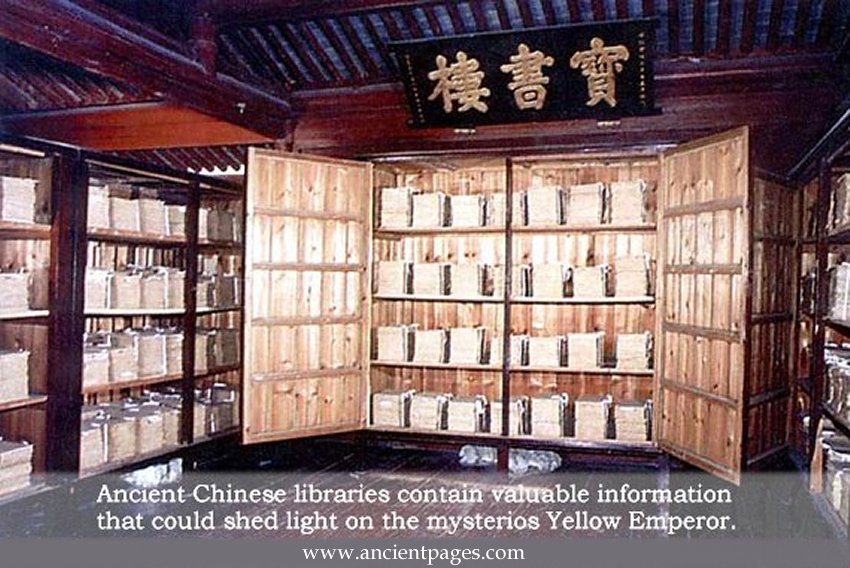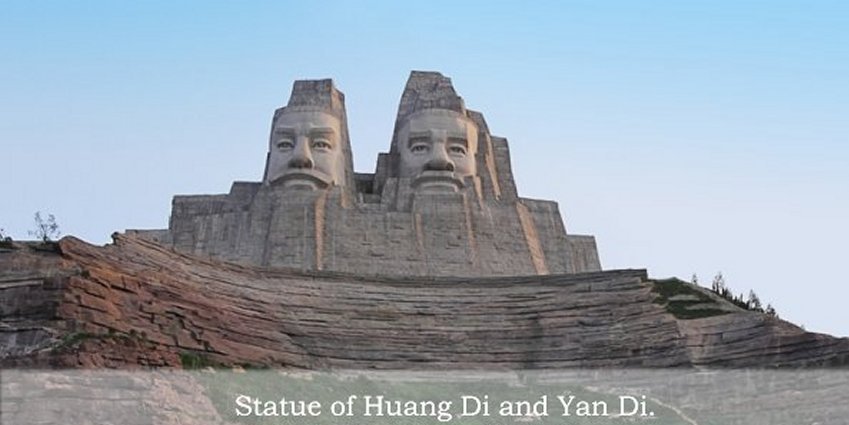Mysteries Of The Yellow Emperor – The ‘Son Of Heaven’ From Regulus
Paul Stonehill - AncientPages.com - Chinese and Japanese archaeologists claim they have discovered in China's southwestern province of Sichuan evidence of the fifth ancient civilization, Japan's Kyodo News reported Monday, October 28, 1996.
The evidence is an earthen stage, unearthed during a joint archaeology project and estimated to date back 4,500 years.
It was found among the remains of an ancient castle near the banks of the Yangtze River 56 miles (90 km) southwest of the city of Chengdu. The archaeologists involved in the excavation project explain that the earthen stage, pointing to advanced knowledge of construction techniques by those who built it, reinforces the possibility of a fifth civilization.
The world's four oldest civilizations are known as Mesopotamia, Egypt, Indus and China's Yellow River. Carbon isotope analysis on earthenware found at the excavation site was used to help identify the age of the castle and stage.
It is a very significant discovery. We may be closer to solving the enigma of the "Yellow Emperor," Huang-ti (27th century B.C.), who, it is said, lived in those misty reaches of time before the Shang dynasty.
In The Beginning
Archaeological evidence suggests that China is one of the cradles of the human race. The earliest known human in China, whose fossilized skull was unearthed in Shanxi Province in 1963, is believed to date back to 600,000 BC.
Around the 4th or 3rd millennium BC, in the New Stone Age, great changes occurred in the lives of the ancient Chinese. Larger numbers of people began living together at settled places, cultivating land, and domesticating animals.
These people made polished stone tools and built shelters in pit dwellings and beehive huts that were covered with reed roofs. Such villages were found mostly in the area of the great bend of the Huang He on the North China Plain. Despite its severe winters, this area was well suited to agriculture. In fact, it closely resembled the other cradles of ancient civilizations, such as the valley of the Nile in Egypt. As we will see, this is an important fact, because there are other striking similarities between the ancient civilizations.
According to Chinese tradition, the Chinese people originated in the Huang He (Hwang Ho or Yellow River) valley.
The legends tell of a creator, P'an Ku, who was succeeded by a series of heavenly, terrestrial, and human sovereigns. Rice was grown in eastern China circa 5500 BC, and about five centuries later an agricultural society developed in the Huang He valley.
The Emperor's Legacy
Chinese civilization owes much to the legendary ruler. Agriculture and husbandry simultaneously developed in ancient times when Huang-ti ruled. Silkworm raising was accomplished earliest in China. Yue Jue Shu says Emperor Huang-ti started the silk clothing industry and cultivated mulberry (for silkworms) and hemp; as the Chinese archaeologists state "it is from historical records" (Selections of Chinese Relics and Archaeology, Foreign Languages Press, Beijing, 1995).
We should be grateful that at least some historical records reach us from the mists of time. Ancient scribes took care to leave us an incredible tale of a very strange being, the one they called the "Yellow Emperor." And it was in Huang-ti's age that the most ancient Chinese writing was "invented."
Like other ancient peoples, the Chinese developed unique attributes.
Their form of writing, developed by 2000 BC, was a complex system of picture writing using forms called ideograms, pictograms, and phonograms.
Such early forms of Chinese became known through the discovery by archaeologists of oracle bones, which were bones with writings inscribed on them. They were used for fortune-telling and record-keeping in ancient China.
In 1899 a small group of Chinese scholars and antiquarians collected quantities of inscribed bones from the fields around Hsiao T'un. Five years passed before enough symbols could be deciphered to reveal the true nature of the "dragon bones."
They were a record of a people who called themselves Shang, and ruled lands surrounding Anyang some four thousand years ago. The objects embedded in the fields of Hsiao T'un came not from dragons but from tortoises and cattle. Shang kings desired to glimpse into the future, and their diviners inscribed the royal inquiries on a carefully scraped and polished tortoiseshell or ox blade or leg bone.
Years later the People's Republic of China archaeologists uncovered thousands more Shang oracle bones. Corps of learned people created a whole new anch of linguistic study, Jia gu shu, the study of shell and bone writing. As scholars pored over the writings of ancient diviners, they reached a provocative conclusion: Shang writing was not the oldest Chinese writing, not by a thousand years at least. The characters used then were already so sophisticated that they undoubtedly had many centuries of development behind them. Very little is known pre-Shang writing.
The Shang Dynasty (1766-1122 BC) is the first documented era of ancient China. The highly developed hierarchy consisted of a king, nobles, commoners, and slaves. The capital city was Anyang, in north Henan Province. Some scholars have suggested that travelers from Mesopotamia and from Southeast Asia brought agricultural methods to China, which stimulated the growth of ancient Chinese civilization. If so, there may be a direct connection with Sumer. The Shang peoples were known for their use of jade, onze, horse-drawn chariots, ancestor worship, and highly organized armies.
A significant aspect of China is its long cultural and national history. The Chinese people have shared a common culture longer than any other group on Earth. The Chinese writing system dates back almost 4,000 years.
Ancient Libraries
The earliest known libraries were connected with palaces and temples.
In China, records of the Shang dynasty were written on animal bones and tortoise shells.
An early library called "The Healing Place of the Soul"; in the palace of Egypt's King Ramses II (1304?-1237 BC) at Thebes, consisted of thousands of papyrus scrolls. Among the most important libraries in the ancient Near East was the palace library of Ashurbanipal (668?-627? BC) at Nineveh in Assyria.
This early type of national library, collected "for the sake of distant days" consisted of over 30,000 clay tablets. Early librarians were usually priests, teachers, or scholars. The first known Chinese librarian was the philosopher Lao Tse, who was appointed keeper of the royal historical records for the Chou rulers about 550 BC. There is a definite connection between Lao Tse and the Yellow Emperor.
Many cultures identify a sacred being as the creator of writing. In Egypt, the honor was shared by Thoth and Isis, while the ancient Greeks thanked Hermes for their writing words.
The Yellow Emperor was a highly gifted "Son of Heaven". Legend goes that he was the inventor of many things such as making clothes, manufacturing boats and vehicles, building houses and palaces, etc. He also had his court officials Lun Ling make musical instruments, Da Nao compile the Heavenly Stems and the Earthly branches (The 10 Heavenly Stems and 12 Earthly branches are used in combination to designate years, months, days and hours), and Ts'ang Chieh invent the Chinese characters. Thus, the Chinese tradition attributes the invention of writing to Ts'ang Chieh, a minister of the heroic "Yellow Emperor," Huang-ti.
When men first learned to write, "all spirits cried in agony, as the innermost secrets of nature were thus revealed."
Chinese mathematics
The origin of Chinese math is surrounded by a great amount of myth since many of the ancient mathematical writings were lost through the decay of the bamboo material they used to write on. It is believed that the Emperor Huang-ti was the first patron of mathematics. Under Huang-ti's rule, his ministers, Tai-mao and Li-shou devised a sexigesimal based number system and corresponding arithmetic.
The Chinese believed that numbers had philosophical and metaphysical properties. The Chinese used numbers "to achieve spiritual harmony with the cosmos." They believed Man's "...existence depended upon numerically specified actions and obligations."
Early Chinese math was presented in a literary form. There was no use of algebraic notation. The digits in their base 10 systems were ciphered and they were written vertically on bark, bamboo, silk, and paper. The traditional Chinese numeral system was a multiplicative grouping system, although a later system, called scientific Chinese numerals was a positional system.
In love...
The oldest books on love are the Chinese "Handbooks of Sex" written 5,000 years ago by the legendary Yellow Emperor, Huang-ti (2697-2598 BC).
...and war
The knowledge of the four useful branches of military knowledge concerned with (1) mountains, (2) rivers, (3) marshes, and (4) plains; and enabled the Yellow Emperor to vanquish four several sovereigns (Napoleon had similar beliefs about the art of war). Ancient Chinese writings confirm that the Yellow Emperor was responsible for the invention of warfare.
In the LIU T`AO it is mentioned that Huang-ti "fought seventy battles and pacified the Empire." Ts`ao Kung's explanation is, that the Yellow Emperor was the first to institute the feudal system of vassals princes, each of whom (to the number of four) originally bore the title of Emperor. Li Ch`uan tells us that the art of war originated under Huang-ti, who received it from his Minister Feng. Huang-ti, or the Yellow Emperor, is referred to as the "Originator of the Chinese Culture", and all people of the Chinese race regard themselves as descendants of Yan Di and Huan-ti.
With the original surname of Gongsun (later changed to Ji) and another name Youxiong Shi, Huang-ti was also known as Xuanyuan Shi as he lived at the Xuanyuan Hill. A clan leader towards the end of China's primitive society, Huang-ti Di was the full other of Yan Di with whom he shared the country. He formed an alliance with Yan Di in later years against the invasion of Chiyou, the chieftain of the Jiuli Tribe. A decisive battle was fought at Zhuolu in the northwest of the present Hebei Province.
The legend goes that at the beginning of the battle, Chiyou sneezed out a thick fog all over the place which lasted three days, and the soldiers of Huang-ti could not tell their directions. Fortunately, Huang-ti led his men out of the fog by the "compass chariot" he had invented and won a complete victory.
The alliance of Huang-ti and Yan Di split after Chiyou was defeated because, it was said, Yan Di intended to infringe upon the various tribes and seize the leading position of the alliance while the chieftains of the tribes preferred to obey Huang-ti. As a result, the two leaders fought at Banquan. After three fierce battles, Huang-ti won the victory and was made the "Son of Heaven" by the tribe chieftains.
Strict and impartial, Huang Di was able to get rid of the evil for the people. It was said that Gu, son of the God of Mount Zhongshan named Zhulong, murdered another god at Mount Kunlun in collaboration with a deity called Qinpi. The Yellow Emperor was indignant at their atrocity and immediately had them killed.
Lao Tse (or Lao Tzu) and Huang-ti
Although ascetics and hermits such as Shen Tao (who advocated that one "abandon knowledge and discard self") first wrote of the "Tao," it is with the sixth century B.C. philosopher Lao Tzu (or 'Old Sage' -- born Li Erh) that the philosophy of Taoism really began. Some scholars believe he was a slightly older contemporary of Confucius (Kung-Fu Tzu, born Chiu Chung-Ni). There is also a close association between Lao Tzu and the legendary Yellow Emperor, Huang-ti.
What was the association between an emperor long gone and the court librarian who founded Taoism? Although deeply rooted in Chinese history Taoism is a way of life rather than a religion. Its essence being strongly based on Lao Tzu's (570?-490? B.C.) writings called the Tao Te Ching. The book is separated into two parts: the first is the "book of the way," the second is the "book of virtue." He believed that harmony existed between Heaven and Earth and that it could be found by anyone, at anytime-all they needed to do was follow the natural flow of nature called the Tao or "the Way."
His basic teaching was that the Tao could not be spoken of, for words cannot describe the infinite Universe.
Alongside the development of Taoism as a philosophy, another more strictly religious interpretation of Taoism was evolving. This "religious" Taoism had its own temples, priests, rites, and symbolic images. Lao Tzu was venerated as a "saint" and imperial sacrifices were made to him. It drew strongly upon the ideas of yin-yang and of the "Five Agents" (metal, wood, water, fire & earth). During this time there began to develop a pantheon of Taoist deities that were often venerated as gods. So prominent were astrology, alchemy, and divination in this stream of Taoism that it had veered away from philosophy to occultism. This movement was sometimes known as Huang-Lao after the legendary Yellow Emperor, Huang-ti, and Lao Tzu.
From this form of Taoism emerged very strong alchemical currents as Taoist practitioners (much like Western mystics a millennium later) at the court of Shih Huang-ti of the Qin (Ch'in) dynasty (221-207 BC) tried to cultivate powers that would transform base metals to gold, and hence would serve as a metonym for the transformation of human qualities to the transcendent. These practitioners were also acclaimed as spirit mediums and experts in levitation.
Was the knowledge of strange powers given to Lao Tzu by those who held the legacy of the Yellow Emperor? Or did the Emperor himself give this knowledge to Lao Tzu?
Sons Of Heaven
The "Yellow Emperor" was a rather interesting entity. I intentionally avoid calling him a human being, not because I seek to offend the Chinese people, but because the information I had collected about Huang-ti (albeit scarce) convinces me otherwise.
The ancient Chinese records mention amazing, wise, and humane (humane, not human-P.S.) beings, the" Sons of Heaven" (this term became emperors' title much later), who had done so much for the then savage dwellers of the Huang He River valley. Before the "Sons of Heaven" appeared on Earth, familiar celestial phenomena preceded all such appearances. Before Huang-ti was born there occurred " a radiance from the great star Chi and the Dipper Constellation (Ursa Major)."
A very ancient, pre-Buddhist religion of Tibet ("bon") described how a mighty "Friend of virtue and kindness" had appeared on Earth:
"...Egg, created by magical forces of gods Sa and Bal, exited under the action of its own weight from the divine bosom of empty sky.
The shell became a defensive armor. The casing defended like amour, and that which is White became a source of strength for heroes. The inner casing became a stronghold for those who had dwelt in it...
From the very center of the Egg came a human being, Possessor of magic force...
Of all the "Sons of Heaven," it was Huang-ti who had left the "largest footprint" in Chinese mythology. He first made his appearance in the Huang He River basin.
Huang-ti was very different from other ancient heroes. He did not enlighten people, did not demand worship. Huang-ti and his helpers were amazingly rational beings. Of course, they did teach the natives all kinds of useful sciences, including acupuncture. However, most important for them were their own affairs. And such affairs were dominated by the creation of complex, and alas, incomprehensible (at least, to us) apparatuses and contrivances.
Mr. Krapiva, a noted Ukrainian researcher of anomalous phenomena, related in his book "UFOs: a hovering enigma of history" (Odessa, 1991) that Huang-ti manufactured twelve gigantic mirrors of unknown nature and used them "following the Moon". Archaeologists in modern China add another detail. They cite The Biography of Huang-ti: "When the Emperor met the West Empress at the Mountains of Wangwu, twelve large mirrors were wrought for use month by month."
According to Mr. Krapiva, the Biography of Huang-ti was based on mysterious legends.
What did the ancient scribes mean by "following the Moon?"
What drove Huang-ti to establish some connection between his "mirrors" and Moon? There is even a more curious detail uncovered by Krapiva.
"Account of Wonders" (sixth century B.C.E) contained the following story:
People of the Mirror Lake tell that where Huang-ti cast his mirrors, there remains a stone that polished them. Creepers (creeping grass - P.S.) do not grow on that stone. Lao Tzu lived in that age: did he see the stone in question?
Miraculous Tripods
Numerous sources relate that Huang-ti manufactured and used some "miraculous tripods." The "tripods" were not used for water, nor was there any fire to heat and prepare food in them. The purpose of such a "tripod" was quite different: it was a "likeness of the Great Infinite," Tao, the concealed engine of the Universe. A "tripod" was approximately 3-4 meters in height, but its volume was relatively small: 100 liters. The legs carried most of their weight. A curious human observer would not be able to glance inside the "tripod," but sources did say that "hundreds of spirits filled its insides." Krapiva, who has studied all such sources available, is of the opinion that a functioning "tripod" emitted some noises, voices.
The legends of ancient China said that the "tripods" depicted "dragons, flying in the clouds"; it was the same "dragon" who eventually arrived and carried off Huang-ti and his colleagues. Most likely the "tripods" were used for distant communications because their location was chosen in such a way that the star Syuan Yuan would be pointed at. It is from that star that Huang-ti arrived on Earth. We know this star as Regulus, of the Leo constellation; more about this curious star later.
There is a mountain, 18 kilometers northeast of Zhaoqing, first called Summit Lake Mountain because there is a lake on its top. Legend says that the Yellow Emperor once had a tripod cast here, hence the present name. It is one of the four famous mountains in south China.
The most interesting quality of the "tripods" was their ability to store knowledge and data. Such a "tripod" knew " favorable and unfavorable signs, knew that which exists and that which has disappeared." Moreover, a "tripod" could remain still, and could walk about, was able to become light and heavy (Krapiva thinks it could somehow manipulate gravitation). The sources listed by Ukrainian scholars are "Records of the foremost deeds of Huang-ti the Great" and "Glorification of the three tripods of Huang-ti" written by Zao Ji.
The Chi Yu Entity
Huang-ti and most of his assistants operated in Northern China. It was there that the Chinese civilization subsequently developed. The south of China was developed by entities whose exact nature is not easily determined: were they living organisms? independent mechanisms? or mechanisms, controlled by living creatures? Ancient sources name them "Chi Yu and his others."
Obviously, they were quite identical. Perhaps the discovery of the "fifth civilization" site at Chengdu, and subsequent excavations will shed some light on those who "developed the South." Krapiva was able to collect some information about Chi Yu. Just like Huang-ti, Chi Yu had four eyes (at least, considered as such), six arms, or manipulators.
The strangest of all was Chi Yu's head: it was made from copper and had a metallic forehead and some tridents in place of ears. According to the local legends, the metallic head was cut off the body (with all appropriate safeguards), and buried separately. Years later this head continued to emit heat. On occasions a reddish steam-like cloud would come from the burial site: the locals worshiped it ("Five books of Huang-ti").
Chi Yu was able to move in the rugged areas, and even fly (for short periods of time). His (or its...) taste for food was quite impressive: all sources suggest that the creature ate "stones and sand": this way it obtained energy that was necessary for the creature's movements.
Were Chi Yu and "his" brothers living creatures? Krapiva thinks that were complex autonomous mechanisms, akin to robots. Actually but one of the creatures would have to be controlled by an intelligent life form, but the natives considered them all as living creatures.
Returning To His Home Star
Huang-ti ruled the land for one hundred years, but his life span was much greater: some sources suggest that he lived for three hundred years. Where he spent the rest of his days, and what activities he was engaged in open to speculation. There are Tao sources who state unambiguously that after one hundred years of his "rule" Huang-ti returned to his home star, "ascended the heavens, and became the ruler of the Great Infinite, again turning into the star Syuan Yuan."
The same star that his "tripods" had pointed at. An ancient Chinese drawing of the Syuan Yuan constellation has been identified by modern astronomers as that of the Leo constellation. Its brightest star is (Alpha Leo), Regulus. We do not know much about this star; we do know that there are very few similarities between our Sun and Regulus. But there is a very curious similarity: there exists, in the Regulus star system, a radio source that emits signals in metric wavebands. In our Solar system, there is also such a source: Earth.
The Essence Of Thunder
Huang-ti's image was that of a "thunder." Aborigines of Australia have similar myths of beings who traveled at great speeds, and emitted "thunder." But Huang-ti was a more defined "thunder": it (the thunder) was identified with elongated drums. That is how the "thunder" was depicted, as bunches of drums, each drum subdivided into four sections. What is more amazing, one of Huang-ti's assistants was known as "prince of thunder"...a navigator?
Huang-ti, "having possessed the essence of thunder" was able to move through space at enormous velocities. He had a "dragon," Changhuan, used by Huang-ti to ascend to Sun. One ancient writing mentioned that this marvelous means of transportation "originates in the land where suns are born," and is very old over three thousand years. But most significant is the notion that the enormous speed has an effect on the movement of Time, and staves off the aging process of the human organism. Biography of Huang-ti states that a "changhuan" covers myriads of miles in a day and that humans who "rides" it can reach an age of two thousand years.
Regulus (Alpha Leo)
Where did Huang-ti fly to? Look through a telescope on a bright starry night. Leo can be found in the Northern Hemisphere in the spring and Southern Hemisphere in autumn. Right Ascension: 11 hours. Declination: 15 degrees. Visible between latitudes 90 and -65 degrees. Best seen in April (at 9:00 P.M.).
Regulus, the 25th brightest star in the sky, means "prince. It has other names:
Cor Leonis ("heart of a lion"); Rex; Al Kalb al Asad; Kabeleced.
The origin of the name for the constellation where Regulus resides is also of interest to us. Leo is the Nemean Lion from the Moon who was sent by Hera to slay Hercules. As Hercules first labor, he killed the lion by strangling it with his bare hands. Legend says that the lion had a hide that could not be punctured by iron, bronze, or stone. Since he couldn't reason with the ferocious beast, Hercules strangled it to death and the local people were very grateful. Hercules wore the skin, which made him invincible. When Hercules died, the lion was returned to the celestial heavens with Hercules. Did the myths of ancient Greeks originate in China, and the "dragon" become a "lion?"
The Chaldeans associated Leo with the sun since it is in the sky during the summer solstice (although this is no longer true, due to the precession of the Earth's axis). Since the Nile floods around this time, the ancient Egyptians worshiped the celestial lion.
Leo to the Egyptians was the place the Sun rose after creation (near Denebola) and so was called Domicilium Solis, the badge of fire and heat, or the House of the Sun.
What secrets will be uncovered by Chinese and Japanese archaeologists? Will the discoveries lead us to the evidence we humans have so longed for, the evidence that ages ago we were not the only intelligent life form on Earth?
Written by Paul Stonehill
Copyright © Paul Stonehill - AncientPages.com Contributor
More From Ancient Pages
-
 Mysterious People Who Appeared Out Of Nowhere
Featured Stories | Sep 1, 2018
Mysterious People Who Appeared Out Of Nowhere
Featured Stories | Sep 1, 2018 -
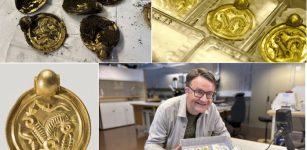 Largest Ancient Gold Treasure Of Its Kind Discovered In Stavanger, Norway
Archaeology | Sep 7, 2023
Largest Ancient Gold Treasure Of Its Kind Discovered In Stavanger, Norway
Archaeology | Sep 7, 2023 -
 DNA Unravels Mysteries Of The Crannogs, Ancient Artificial Islands Older Than Stonehenge
Archaeology | Oct 10, 2022
DNA Unravels Mysteries Of The Crannogs, Ancient Artificial Islands Older Than Stonehenge
Archaeology | Oct 10, 2022 -
 Unexplained Historical Mass Disappearances – Lost Without Trace – Part 1
Featured Stories | May 31, 2019
Unexplained Historical Mass Disappearances – Lost Without Trace – Part 1
Featured Stories | May 31, 2019 -
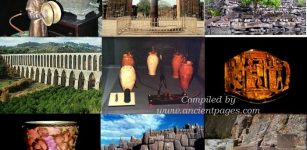 10 Remarkable Advanced Ancient Technologies Ahead Of Their Times
Ancient Technology | Jul 23, 2019
10 Remarkable Advanced Ancient Technologies Ahead Of Their Times
Ancient Technology | Jul 23, 2019 -
 First Time A Meteorite Killed A Person In Known History Revealed In Old Documents
Archaeology | Apr 29, 2020
First Time A Meteorite Killed A Person In Known History Revealed In Old Documents
Archaeology | Apr 29, 2020 -
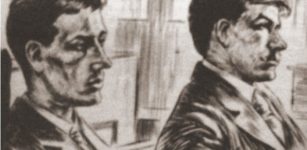 On This Day In History: The U.K.’s First Murder Case Solved By A Fingerprint – On March 27, 1905
News | Mar 27, 2017
On This Day In History: The U.K.’s First Murder Case Solved By A Fingerprint – On March 27, 1905
News | Mar 27, 2017 -
 Ancient Tradition And True Meaning Of Candy Canes
Christmas Traditions | Dec 26, 2024
Ancient Tradition And True Meaning Of Candy Canes
Christmas Traditions | Dec 26, 2024 -
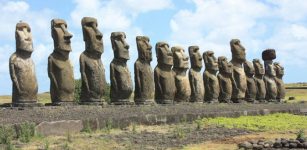 New Attempt To Solve The Easter Island Mystery – What Did Rapa Nui Look Like Before Europeans Arrived?
Archaeology | Sep 20, 2017
New Attempt To Solve The Easter Island Mystery – What Did Rapa Nui Look Like Before Europeans Arrived?
Archaeology | Sep 20, 2017 -
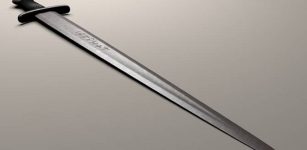 Unravelling The Mystery Of The Ulfberht Sword – An Ancient Viking Artifact Far Ahead Of Its Time
Artifacts | Feb 11, 2014
Unravelling The Mystery Of The Ulfberht Sword – An Ancient Viking Artifact Far Ahead Of Its Time
Artifacts | Feb 11, 2014 -
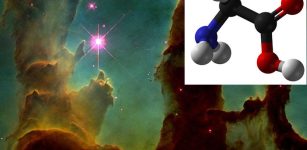 Carbon-12 – A Critical Gateway To The Birth Of Life Is Produced In Stars – Did Life Come From Cosmos?
Human Beginnings | May 23, 2022
Carbon-12 – A Critical Gateway To The Birth Of Life Is Produced In Stars – Did Life Come From Cosmos?
Human Beginnings | May 23, 2022 -
 Food And Clothing Of Middle Class Of The Sumerian Society
Ancient History Facts | Aug 2, 2017
Food And Clothing Of Middle Class Of The Sumerian Society
Ancient History Facts | Aug 2, 2017 -
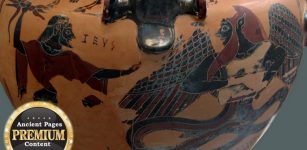 Mysterious Shape-Shifting Beings In Ancient Greece
Featured Stories | Nov 12, 2014
Mysterious Shape-Shifting Beings In Ancient Greece
Featured Stories | Nov 12, 2014 -
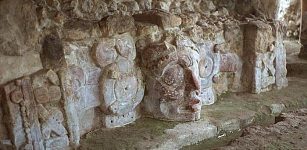 Edzna: Ancient Maya City With Sophisticated Underground System Of Canals To Control Unpredictable Floods
Featured Stories | Jun 2, 2021
Edzna: Ancient Maya City With Sophisticated Underground System Of Canals To Control Unpredictable Floods
Featured Stories | Jun 2, 2021 -
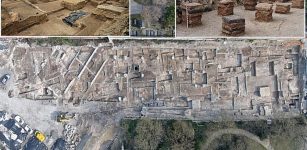 A Huge Site Dated To Roman-Era Unearthed In Reims (Marne), France
Archaeology | Mar 20, 2023
A Huge Site Dated To Roman-Era Unearthed In Reims (Marne), France
Archaeology | Mar 20, 2023 -
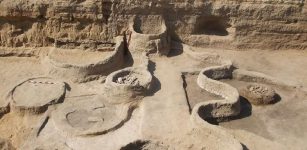 Part Of Long-Lost Pelusiac Branch Of Nile Uncovered In Egypt
Civilizations | Sep 20, 2015
Part Of Long-Lost Pelusiac Branch Of Nile Uncovered In Egypt
Civilizations | Sep 20, 2015 -
 Ancient Copper Ingots Are Unlocking Iron Age Secrets
Archaeology | Dec 13, 2021
Ancient Copper Ingots Are Unlocking Iron Age Secrets
Archaeology | Dec 13, 2021 -
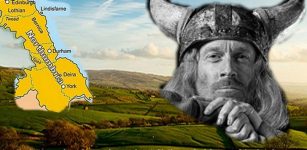 Famous Viking Warrior Eric “Bloodaxe” Haraldsson: King Of Norway
Featured Stories | Sep 29, 2016
Famous Viking Warrior Eric “Bloodaxe” Haraldsson: King Of Norway
Featured Stories | Sep 29, 2016 -
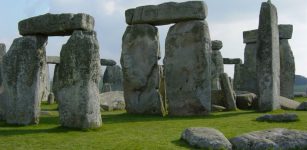 Stonehenge May Have Aligned With The Moon As Well As The Sun
Featured Stories | Jun 4, 2024
Stonehenge May Have Aligned With The Moon As Well As The Sun
Featured Stories | Jun 4, 2024 -
 On This Day In History: British Fleet Attacked The Spanish ‘Invincible Armada’ – On July 21, 1588
News | Jul 21, 2016
On This Day In History: British Fleet Attacked The Spanish ‘Invincible Armada’ – On July 21, 1588
News | Jul 21, 2016


